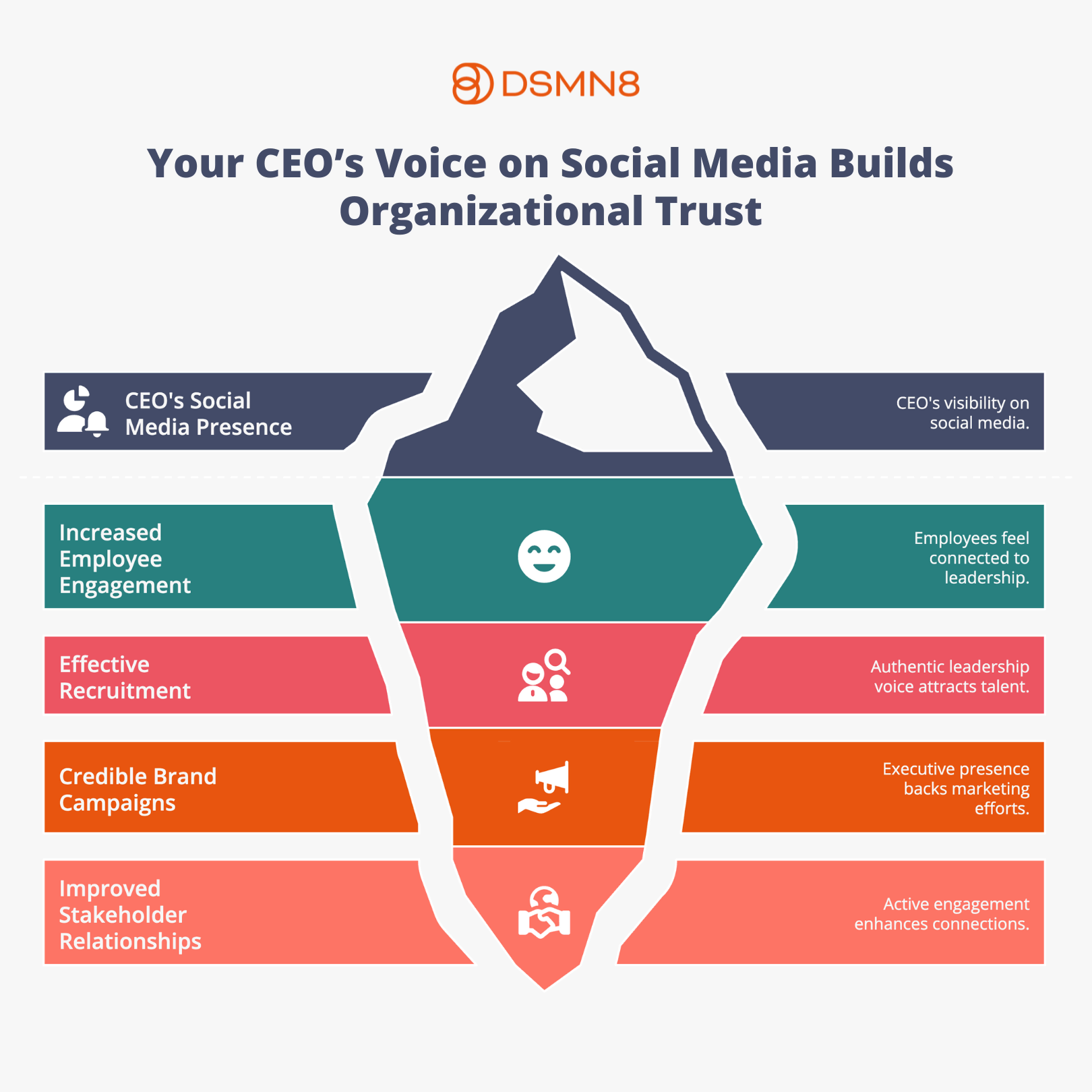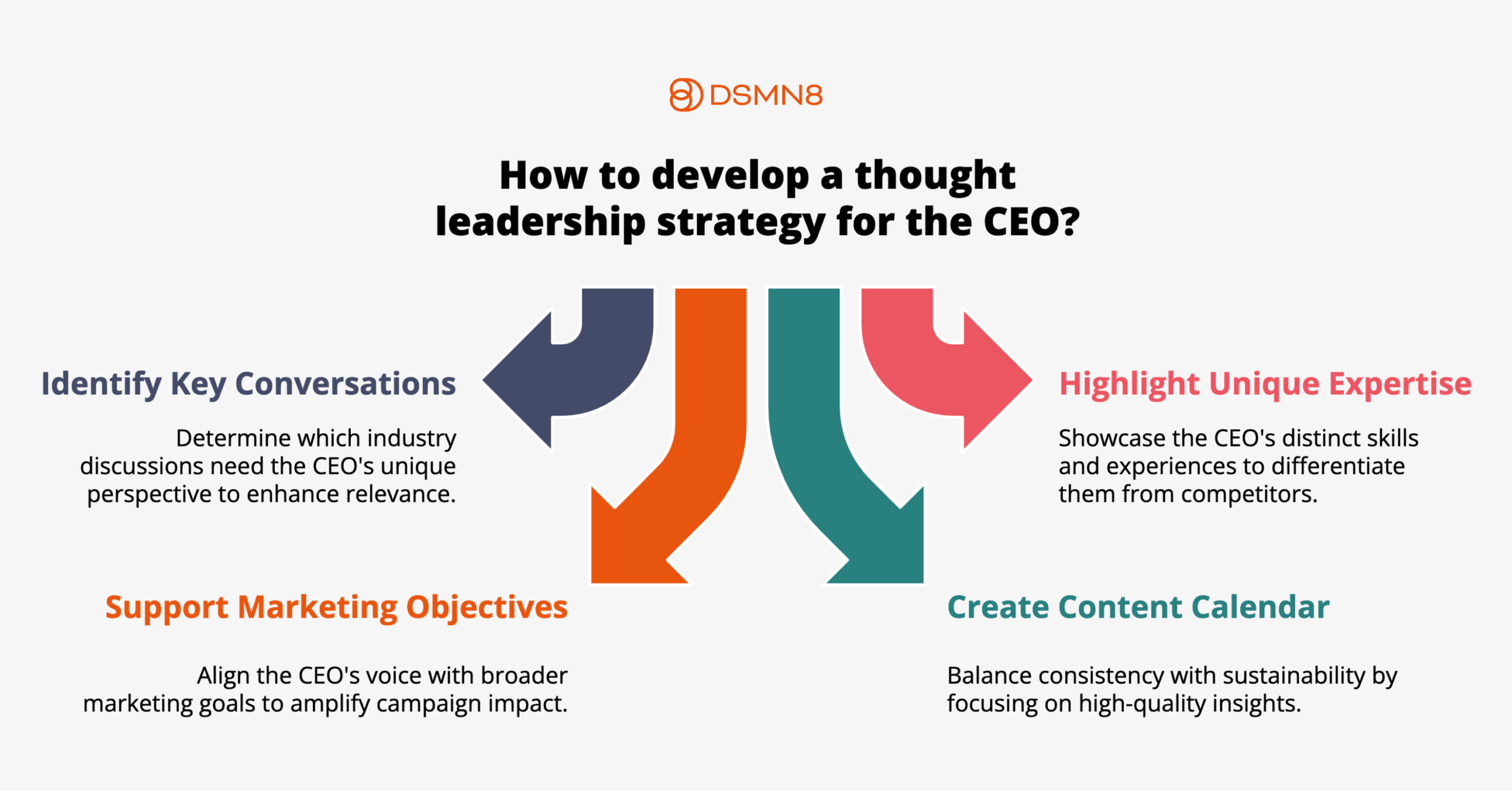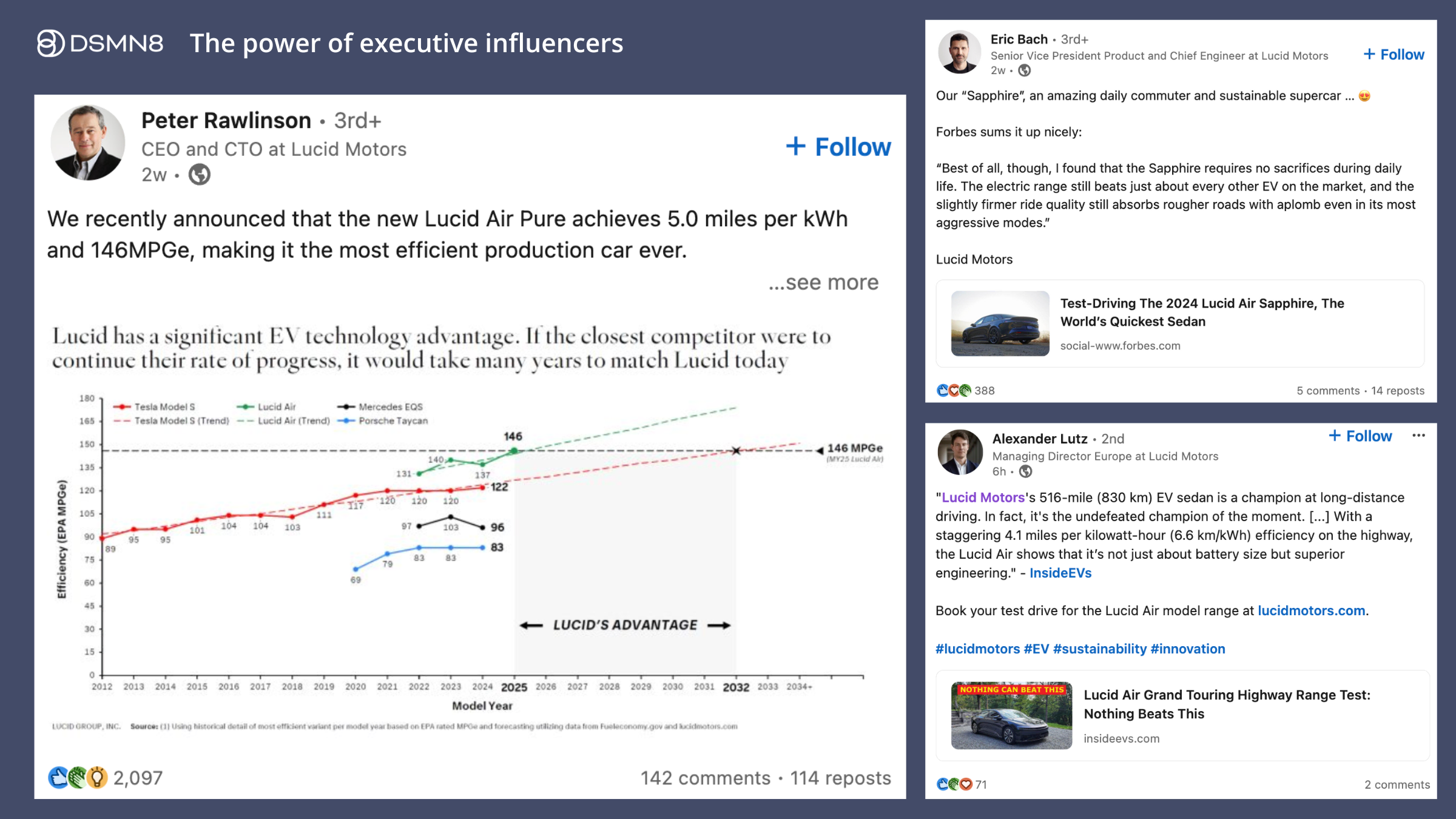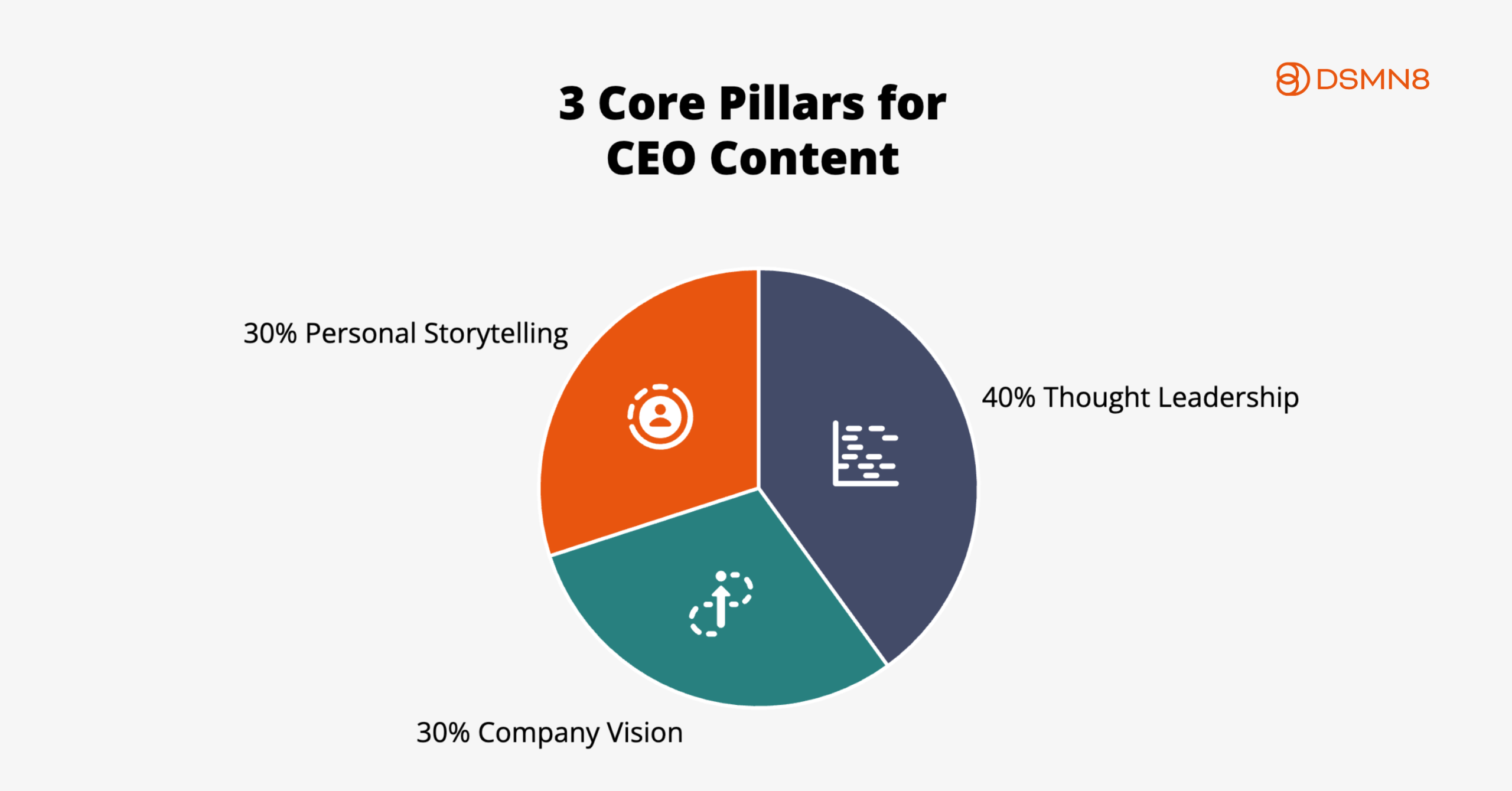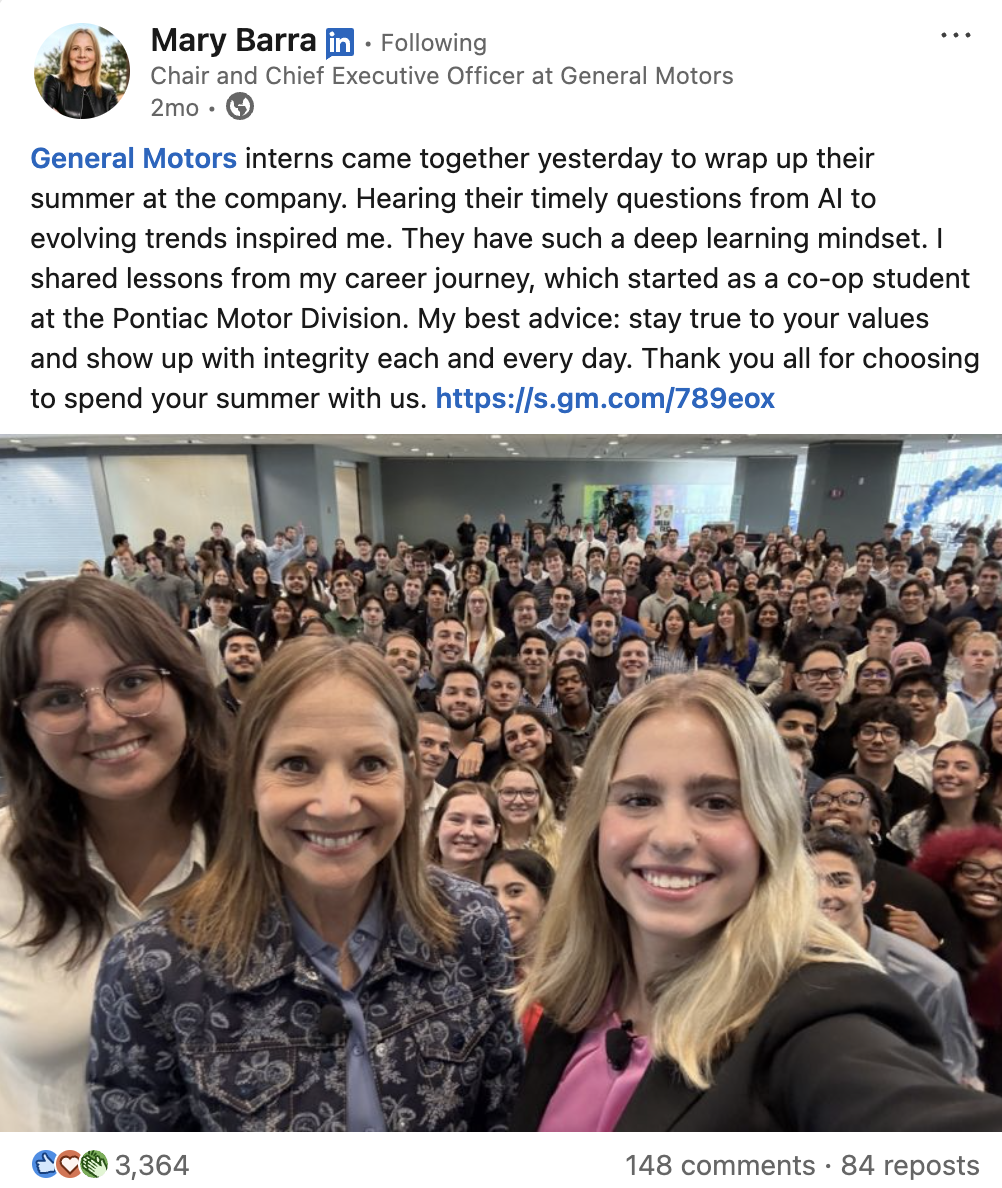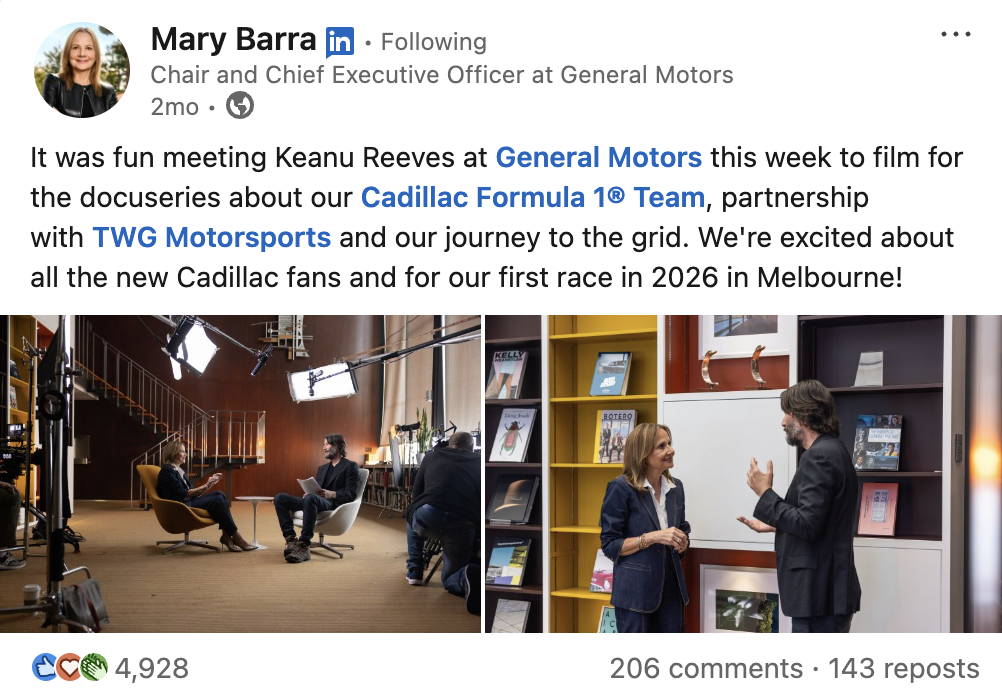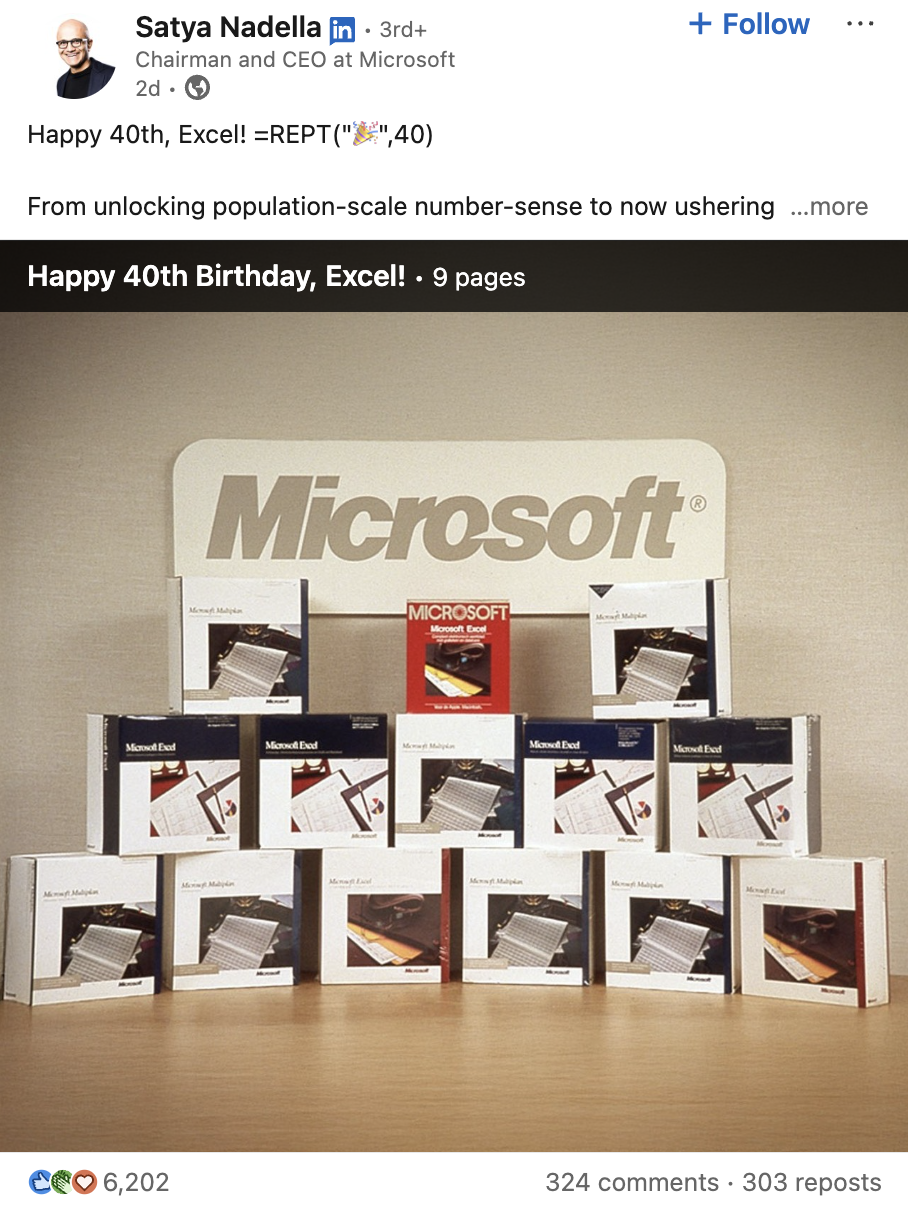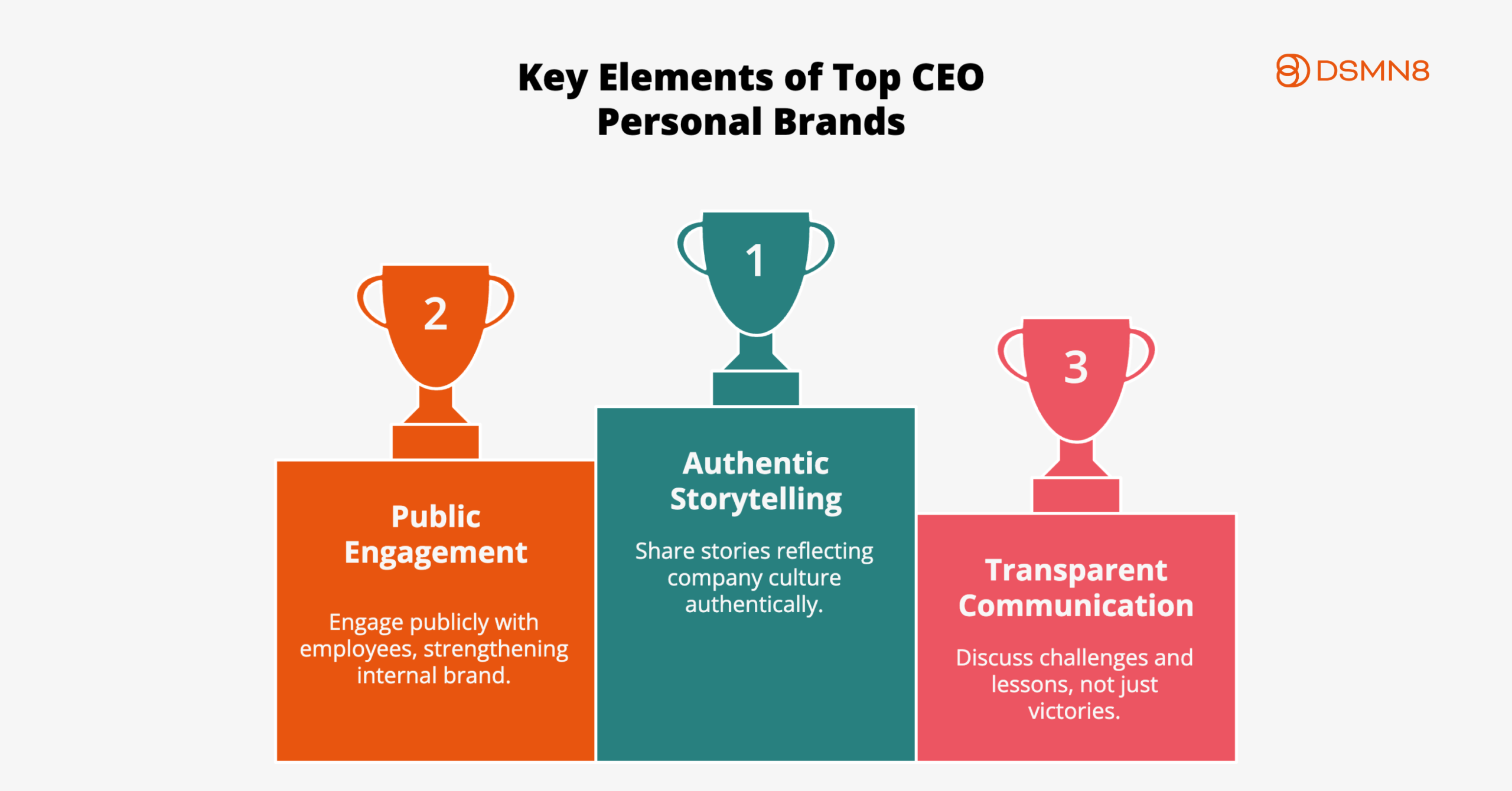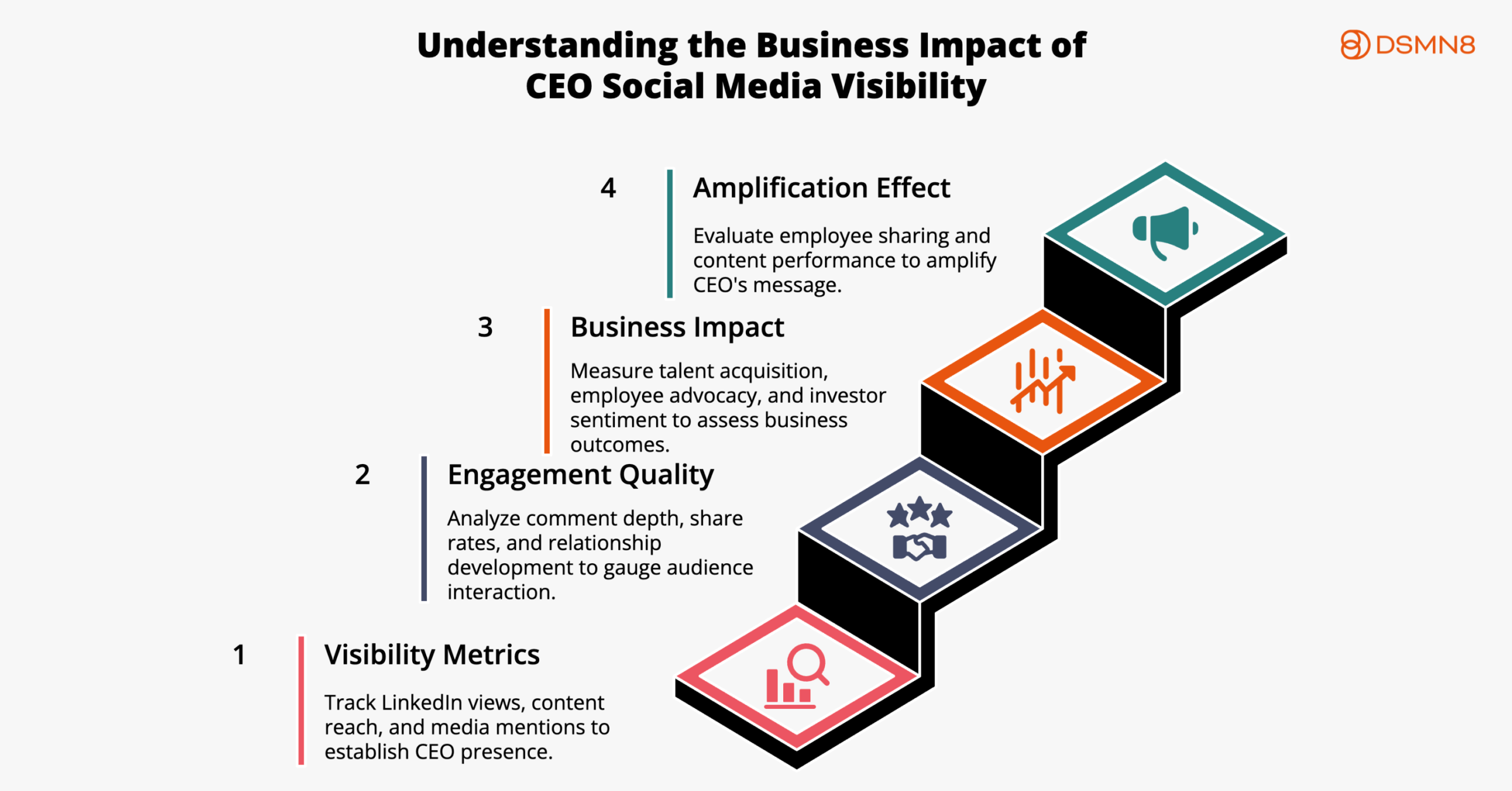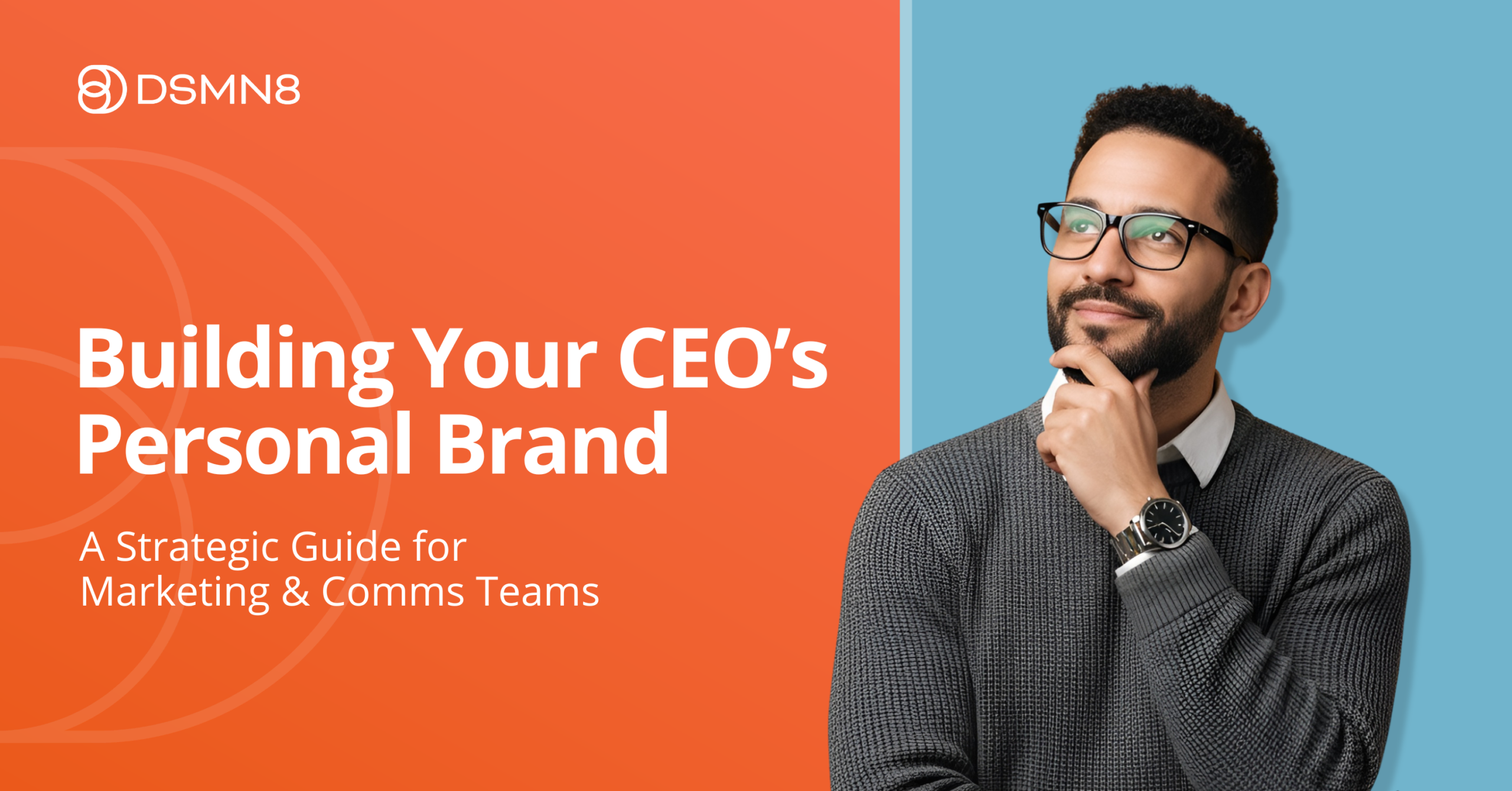
What's on this page:
- The Statistics: Why CEO Personal Brands Matter.
- Making the Case: Why Executive Visibility Is Business-Critical.
- Building Your CEO Personal Branding Program.
- LinkedIn: Your Primary Platform for Executive Visibility.
- Benchmarking Against Best-in-Class CEO Brands.
- Measuring Impact: Proving ROI on Executive Visibility.
- Scaling Your Executive Personal Branding Program.
- Getting Started: Your 90-Day Implementation Plan.
- Final Thoughts & Taking the Next Step.
- Additional Resources
When prospects research your company, they don’t stop at your website; they look up your CEO.
When top talent evaluates your employer brand, they check your leader’s LinkedIn profile.
When investors assess opportunities, they gauge whether your CEO can articulate a compelling vision.
All this to say: your CEO’s personal brand is important.
As a marketing or communications professional tasked with building executive visibility, you’re managing one of your organization’s most valuable channels.
This guide will help you develop, implement, and scale a CEO personal branding strategy that delivers measurable business impact.
The Statistics: Why CEO Personal Brands Matter
First, let’s take a look at the data.
Research shows that 82% of employees will research a CEO’s online presence when considering whether to join a company, and people prefer to work for leaders who use social media four times more than leaders who do not.
Your CEO’s personal brand isn’t a vanity project.
It’s a strategic asset that directly impacts recruitment, employee engagement, and business outcomes.
In fact, 92% of professionals say they’re more likely to trust a company whose senior executives are using social media, and 71% of consumers are more likely to buy from a company if its CEO is active on social media.
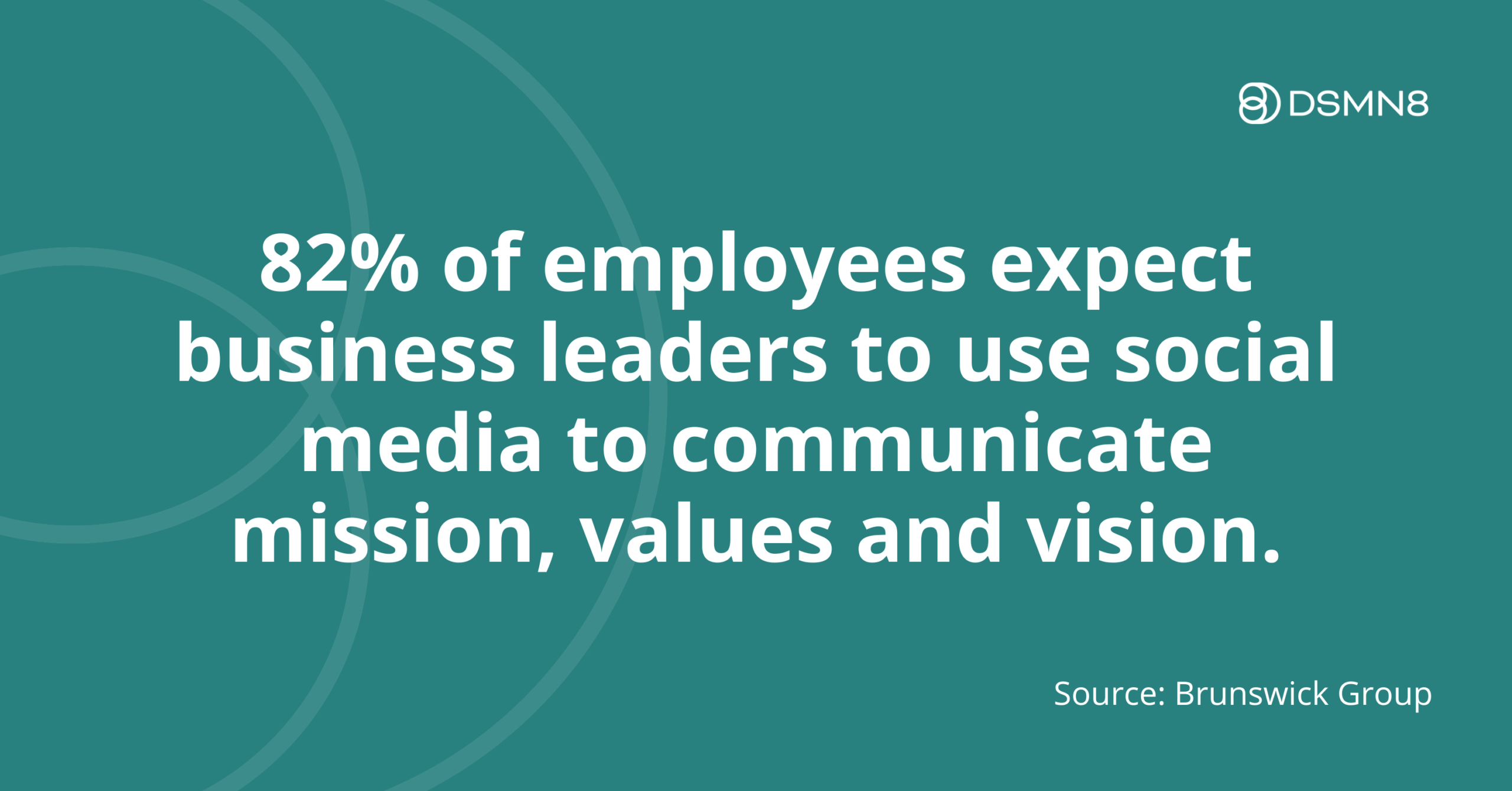
Making the Case: Why Executive Visibility Is Business-Critical
1. Stakeholder Expectations Have Changed
Today’s stakeholders expect direct access to leadership voices.
The invisible CEO model no longer works.
In fact, 82% of employees now expect leaders to use social media to communicate mission, vision, and values.
Investors want to understand leadership thinking. Employees want connection to company vision. And customers want to know the values driving organizational decisions.
When your CEO isn’t visible, you create a narrative vacuum… one that competitors, critics, or misinformation will fill.
Consider this: 53% of CEOs not on social media have inaccuracies in their online search profile. Your job is to help leadership understand that visibility isn’t optional; it’s competitive defense.
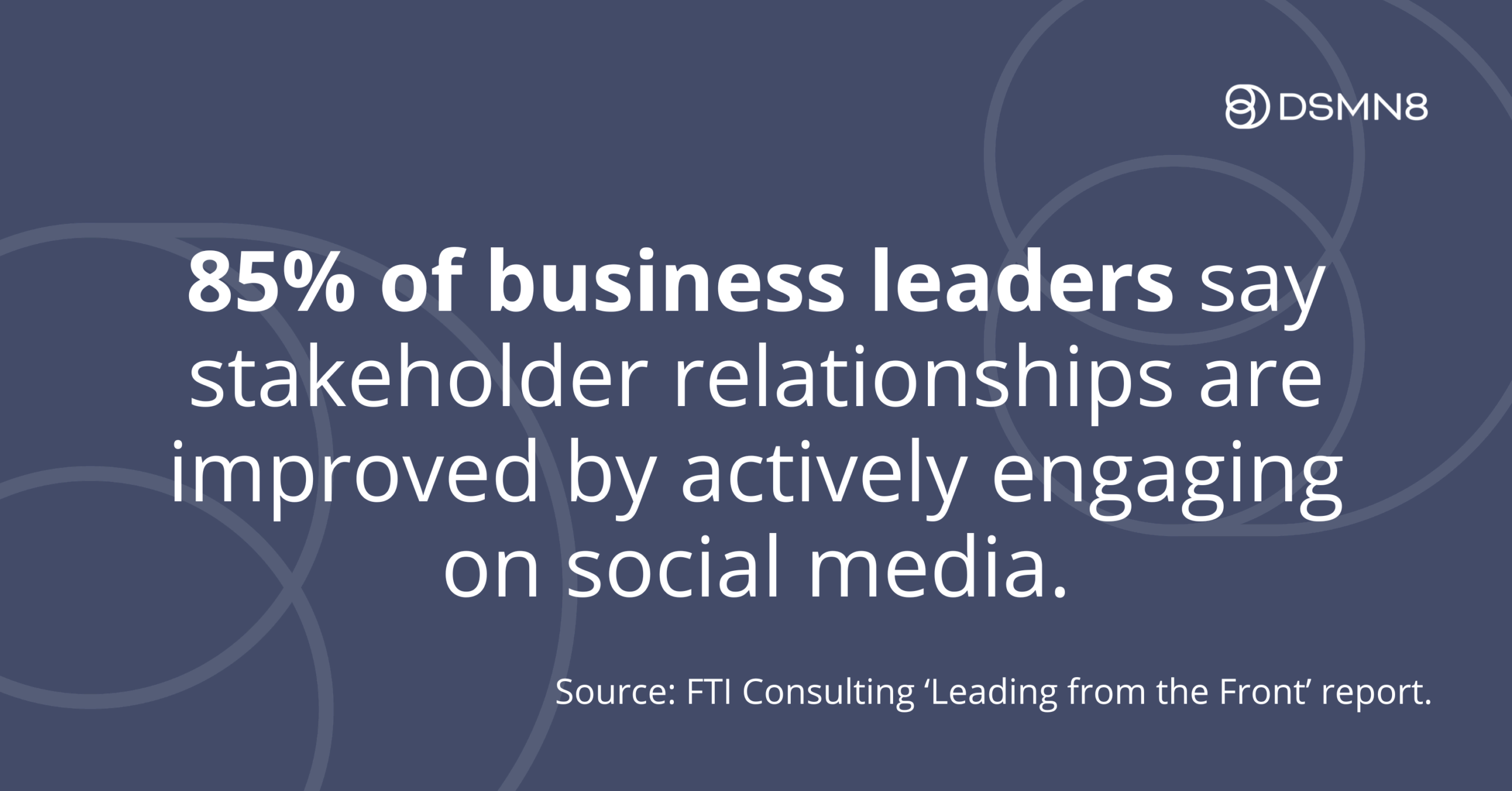
2. Personal Brands Drive Organizational Trust
A CEO’s voice humanizes your brand.
Behind every campaign you launch, every product release, and every quarterly result are decisions and values.
When your leader shares their perspective, you transform corporate messaging into relatable, trustworthy communication.
And with increasing AI-generated content filling up social media feeds, showing the human side of your org makes you stand out.
The data backs this up:
86% of executives who work with a social CEO consider their leadership “open and honest,” and 85% of business leaders say their stakeholder relationships are improved by actively engaging on social media.
This visibility directly impacts the work of HR, marketing, communications, and recruitment teams:
- Employees are more engaged when they feel connected to their leadership.
- Recruitment becomes more effective with an authentic leadership voice.
- Brand campaigns gain credibility when backed by executive presence.
In fact, posts where CEOs highlight employee accomplishments are three times more likely to exceed engagement benchmarks than any other topic.
3. Competitive Differentiation Through Thought Leadership
A strong CEO personal brand creates business advantages you can measure: earlier invitations to industry conversations, inbound partnership inquiries, increased media coverage, and improved brand perception.
Your role here is to position your CEO as a thought leader, not just a company representative, and to track the ROI that proves executive visibility is worth the investment.
Building Your CEO Personal Branding Program
The reality is that most CEOs face two major challenges: lack of time and lack of social media expertise.
In fact, 67% of senior business leaders want support from social media experts to drive their digital impact, and one in five senior leaders would like all of their social content to be written by an expert.
This is where having a structured approach and making it as easy as possible for leaders makes all the difference.
Developing a Thought Leadership Strategy
Your goal isn’t to make your CEO comment on everything, but instead to strategically position them where their voice matters.
Start by identifying:
- Which industry conversations need your CEO’s unique perspective?
- What expertise or experience sets your leader apart?
- Where can your CEO’s voice support broader marketing objectives?
- How can executive content amplify your campaigns?
💡 Create a content calendar that balances consistency with sustainability. One high-quality insight per week typically outperforms daily, generic posts.
Building Crisis Communication Resilience
The worst time to establish your CEO’s personal brand is during a crisis. Leaders with established visibility can address challenges directly, with credibility already in place.
Your communications strategy should include:
- Regular executive visibility to build trust.
- A direct channel (typically LinkedIn) for rapid, authentic leadership communication.
- Pre-approved messaging frameworks your CEO can adapt when needed.
- Crisis scenarios where personal CEO communication is preferable to corporate statements.
Balancing Authenticity with Brand Alignment
Your challenge: helping your CEO sound human while representing organizational values consistently.
This is where you can work with your leadership team to identify:
- Personal stories that illustrate company values.
- Leadership lessons that resonate with your target audiences.
- Appropriate levels of vulnerability that humanize without oversharing.
- The tone and voice that feels authentic to your CEO while supporting brand positioning.
The best CEO content feels personal but aligns with your broader marketing narrative.
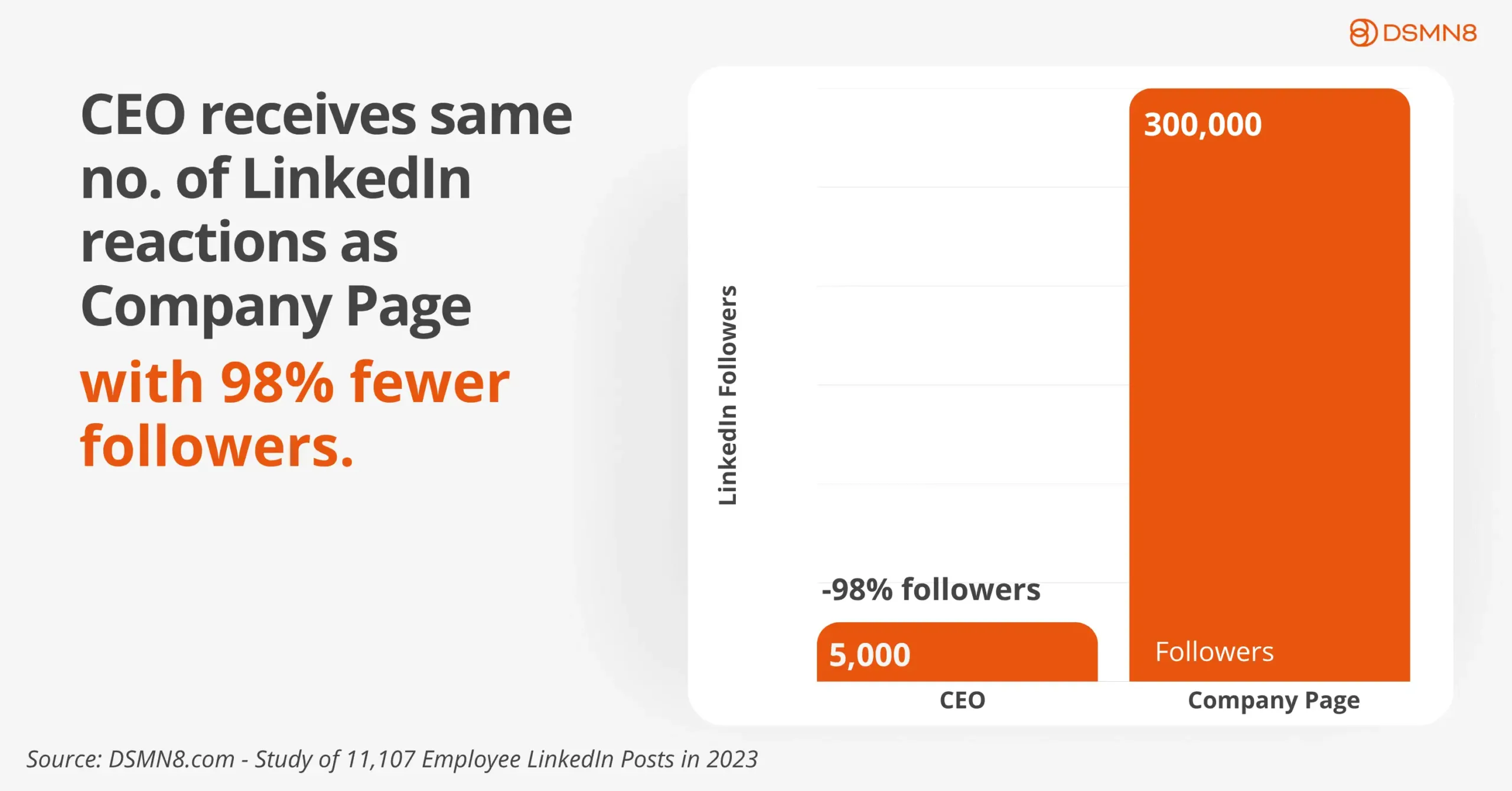
LinkedIn: Your Primary Platform for Executive Visibility
For most B2B organizations, LinkedIn delivers the highest ROI for CEO personal branding.
It’s where your key stakeholders gather, and where executive content gets the most traction.
The numbers speak for themselves: 87% of FTSE 100 executive committee members have a LinkedIn presence, and of Fortune 500 CEOs on social media, 98% use LinkedIn.
Even more compelling: our research shows that a CEO can generate the same number of LinkedIn reactions as the company page with just 1.67% of the followers.
That’s the amplification power of personal branding over corporate channels.
Here’s a great real-world example:
DSMN8’s VP of Marketing, Jody Leon, sparked a powerful discussion on LinkedIn by asking, “Is your CEO posting on LinkedIn?”
Jody highlighted Lucid Motors CEO Peter Rawlinson as a standout example because his posts blend thought leadership with authenticity, showing how leadership visibility sets the tone for company culture.
The conversation took off, proving just how much appetite there is for CEO-driven storytelling and advocacy.
👉 See Jody’s full post for inspiration on how CEOs can set the tone for employee advocacy.
Optimizing Your CEO's Profile
Audit your CEO’s LinkedIn profile as a brand asset:
✍️ Headline: Move beyond job titles. Position your CEO’s expertise and value proposition. “Building [outcome] for [industry]” performs better than “CEO at [Company].”
🏙️ Banner image: Use this premium visual real estate to reinforce your company mission, showcase its culture, or highlight key initiatives.
💡 About section: Rewrite corporate bio language into storytelling. Why does your CEO do this work? What drives the company’s mission? Make it conversational and purposeful.
Creating a Sustainable Content Strategy
The foundation of sustainable CEO content is a repeatable process that doesn’t overwhelm your executive’s schedule.
We’ve developed a proven 5-step CEO Content Framework that turns content creation from a burden into a streamlined workflow:
This framework works because it respects CEO time while maintaining authenticity. Your executive contributes insights, not drafting time.
Check out the full CEO Content Framework to dive deeper into this.
When it comes to the content itself, focus on these three core pillars:
1. Thought leadership (40%): Industry insights, trend analysis, perspective on challenges your audience faces.
2. Company vision (30%): Where you’re headed, why it matters, how you’re different.
3. Personal storytelling (30%): Leadership lessons, values in action, employee spotlights, behind-the-scenes moments.
Diversify your formats based on what resonates with your audience and what your CEO finds comfortable.
If they’re happy to create videos, great! If not, create a mix of short-form posts with longer thought leadership posts/articles.
Driving Meaningful Engagement
Remember, executive personal branding isn’t just about broadcasting; it’s relationship-building at scale. Engaging isn’t optional.
- Respond to comments within 24 hours (you can draft responses for CEO approval)
- Celebrate employee achievements to reinforce culture
- Engage with peer executives’ content to build industry relationships
- Comment meaningfully on industry discussions to increase visibility
Taking this approach amplifies reach and signals that your CEO is part of the conversation, not above it.
Benchmarking Against Best-in-Class CEO Brands
Show stakeholders what good looks like: share examples when discussing your strategy internally.
Study executives like Satya Nadella (Microsoft) or Mary Barra (GM).
Their influence comes from a consistent, values-driven presence.
Mary’s content is the perfect mix of highlighting the work General Motors does while celebrating company culture.
Scroll through her profile and you’ll find posts about their latest launches and progress with the Cadillac F1 team and media features in publications like the Wall Street Journal, but also selfies with a group of interns.
It really does add that human element, showcasing GM as an inspiring place to work.
Read the case study to find out how GM reached 20 million people in 6 months with DSMN8.
Satya from Microsoft takes a different but equally powerful approach: leaning into his technical expertise to explain new product/feature launches and share Microsoft’s latest research.
While you’ll find traditional CEO comms on his page, including notes from Annual Meetings, Satya also shares “fun” content like a 5-day AI challenge and nostalgia-driven posts featuring old Microsoft branding.
It’s clear that Microsoft’s executive social media strategy isn’t just focused on Satya. He often reshares posts by other senior leaders, including CMOs and Vice Presidents of various Microsoft business units.
The key takeaway? Successful CEO brands:
- Share stories that authentically reflect company culture
- Engage publicly with employees, strengthening internal brand
- Discuss challenges and lessons, not just victories
Measuring Impact: Proving ROI on Executive Visibility
To maintain support for your executive social media program, you’ll need to connect it to business outcomes.
Here’s a measurement framework to do exactly that:
1. Visibility Metrics
- LinkedIn profile views and follower growth
- Content reach and impressions
- Media mentions and speaking opportunities
- Google search visibility for CEO name and company
2. Engagement Quality
- Comment depth and sentiment
- Share rates and conversations sparked
- Executive relationship development
- Inbound partnership inquiries
3. Business Impact
- Talent acquisition metrics (application quality, offer acceptance rates)
- Employee advocacy participation
- Investor sentiment and fundraising outcomes
- Sales cycle influence
4. Amplification Effect
- Employee sharing of CEO content
- Reach multiplier through advocacy programs
- Content performance compared to corporate channels
Present quarterly reports to leadership showing how CEO visibility supports broader marketing and business objectives.
📊 DSMN8’s Analytics Suite helps with this!
Scaling Your Executive Personal Branding Program
Creating Sustainable Workflows
CEO time is scarce. The key is building processes that maximize impact while minimizing time investment.
We’ve found that successful programs follow our CEO Content Framework, a system that requires just 40 minutes of CEO time per month.
The secret? You do the heavy lifting while your CEO contributes insights and quick approvals.
The framework in practice:
- Monthly insight collection: Ongoing, passive capture through Slack, meetings, or observations.
- Bi-weekly refinement calls: Two 30-minute sessions to extract content ideas.
- Content creation: You invest the time; CEO invests none.
- Quick approvals: 10 minutes or less per post review.
- Automated publishing: Schedule and post without ongoing CEO involvement.
This approach transforms CEO content from “one more thing” into a sustainable program that runs smoothly alongside their actual responsibilities.
DSMN8’s Executive Influencer Platform makes this process easy.
With secure delegate access, marketing and comms professionals can schedule content (or submit for approval) on behalf of executives and monitor the impact, no password sharing required.
Here’s a brief overview of how it works:
Leveraging Employee Advocacy
Amplifying CEO content through your team takes all of this to the next level.
Employee advocacy platforms like DSMN8:
- Make it easy for employees to share CEO posts with their networks.
- Multiply reach without additional time investment from executives.
- Demonstrate broader organizational alignment with leadership.
Integrating with Broader Marketing Initiatives
By syncing their posts with what’s already happening in your organization, you can amplify your impact without creating extra work.
Think about timing CEO posts to coincide with product launches. When your executive shares their perspective on a new release, it adds authenticity and reaches audiences your marketing team might not touch.
Hiring? Your CEO’s voice is gold during recruitment drives. A post about company culture or vision from the top can attract talent in ways a job listing never will.
When PR or media opportunities come up, a well-timed LinkedIn post can set the stage and extend the conversation well beyond a single interview or article.
And don’t forget industry events. When your executive shares insights around key conferences, you’re leading the conversation, not just participating in it.
All of this will help create a cohesive story that makes everything work harder.
Getting Started: Your 90-Day Implementation Plan
Final Thoughts & Taking the Next Step
CEO personal branding done right humanizes your brand, amplifies your campaigns, and creates a competitive advantage.
Your next moves:
- Audit current state: What’s your CEO’s digital footprint today? What opportunities are you missing?
- Build your business case: Use this framework to demonstrate ROI potential to leadership.
- Start small, scale smart: Launch with a manageable cadence, prove impact, then expand.
Ready to benchmark your CEO’s current executive presence?
👉 Grab an Executive Influencer Health Check to see how their presence compares with your competitors, and identify specific opportunities for impact.
Ready to see how DSMN8’s executive influencer platform works?
Additional Resources
More on Building Your CEO’s Personal Brand:
Emily Neal
SEO and Content Specialist at DSMN8. Emily has 10 years experience blogging, and is a pro at Pinterest Marketing, reaching 1 million monthly views. She’s all about empowering employees to grow their personal brands and become influencers.

